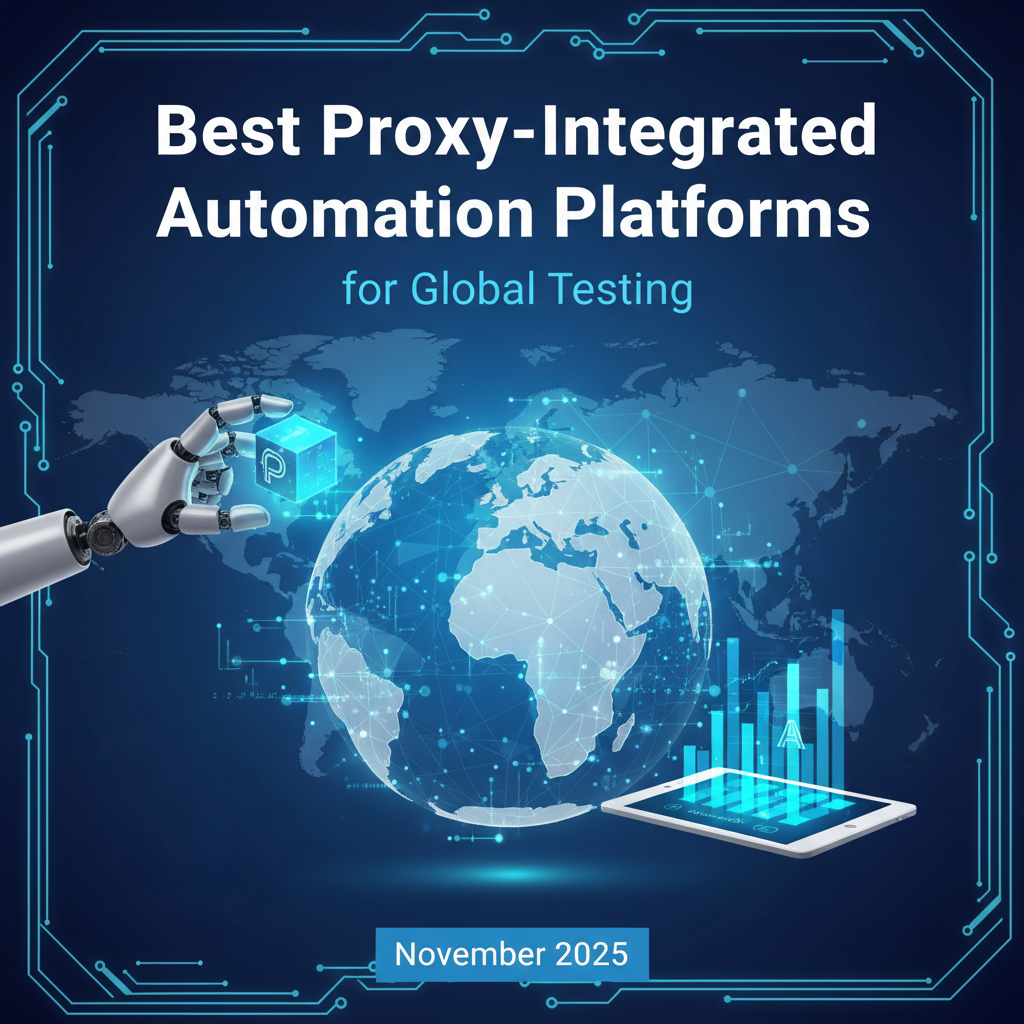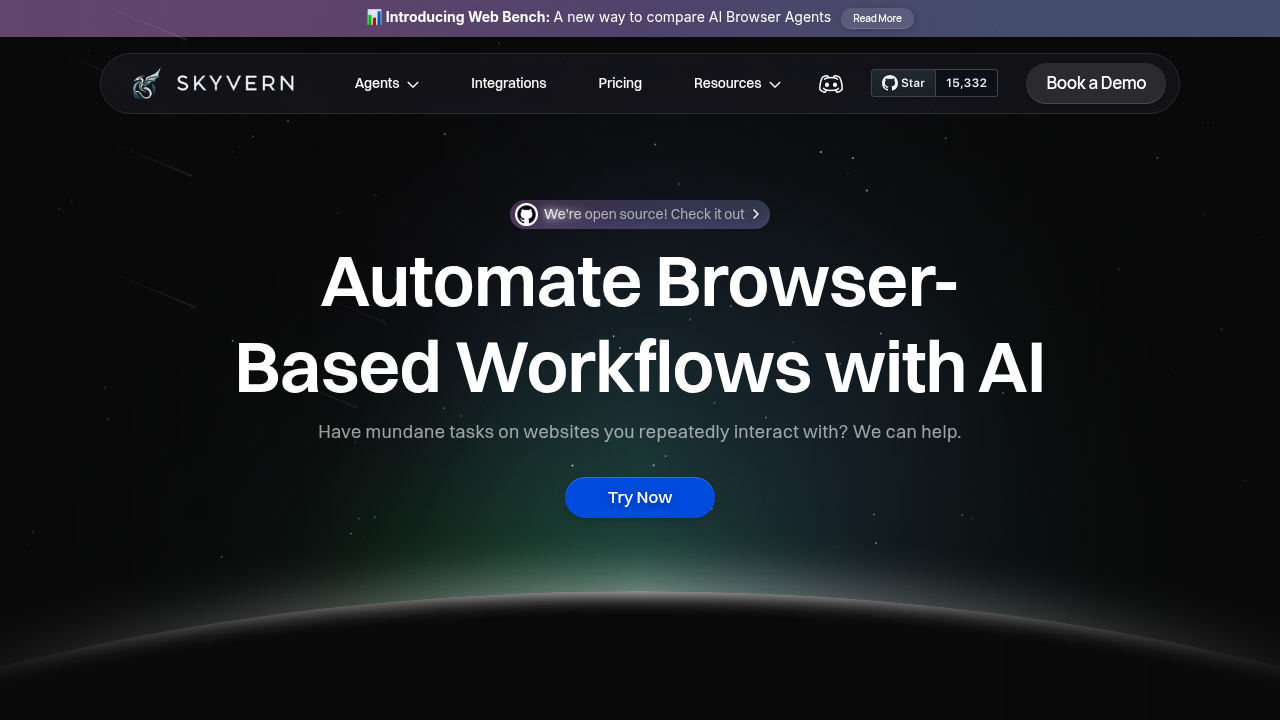Best Proxy-Integrated Automation Platforms for Global Testing (November 2025)

Everyone talks about global testing, but actually doing it means dealing with proxies, rotation settings, and geographic targeting that may or may not work as advertised. Location-based automation should be straightforward: pick a location, run your workflow, get accurate results. Instead, most solutions make you juggle separate proxy providers and automation frameworks. We compared the platforms that claim to simplify this process to find out which ones actually save you time and which ones just add another layer of complexity to your stack.
TLDR:
- Proxy automation routes browser workflows through specific locations for price testing and geo-restricted access
- Traditional tools require separate proxy setup while Skyvern adapts to site changes automatically
- Most alternatives either provide proxies without automation or scripts needing manual proxy configuration
- Skyvern handles CAPTCHAs, 2FA, and form filling while maintaining geographic authenticity
What are Proxy-Integrated Automation Platforms?
Proxy-integrated automation solutions combine browser automation capabilities with proxy network infrastructure. This pairing lets you run automated workflows that appear to originate from specific geographic locations, whether you need to test a website's behavior in different countries or execute tasks that require residential IP addresses. These tools matter because many workflows require geographic authenticity:
- Price comparison across regions depends on seeing the actual prices displayed to users in different countries, not your default location's pricing
- Localized content verification requires confirming that region-specific messaging, product availability, and compliance notices appear correctly to users in each target market
- Accessing geo-restricted resources means routing requests through IPs that match the required location, whether for testing regional features or gathering market intelligence
AI web agents take this further by navigating websites, extracting data, and making decisions autonomously while routing traffic through proxy networks to handle location-specific requirements at scale.
How We Ranked Proxy-Integrated Automation Platforms
We looked at each solution based on criteria that matter for real-world proxy automation deployments. These aren't theoretical benchmarks but practical considerations that affect whether a tool actually solves your geographic targeting needs. Our ranking framework assessed:
- Proxy network scale and IP pool quality. This includes residential vs datacenter coverage and rotation capabilities.
- Geographic targeting precision. We looked at how granular the targeting was, from country-level down to state, city, or ZIP code.
- Automation depth. We assessed whether the tool offers basic scripting support or AI-driven capabilities like form filling and dynamic navigation
- API design and integration complexity. We measured how quickly you can connect proxy infrastructure to your existing workflows
- Pricing structure transparency. We looked at the overall cost, including whether costs scale predictably with usage
We gave more weight to solutions that combine proxy networks with automation capabilities above standalone proxy providers requiring separate scripting layers.
Skyvern: AI-Powered Browser Automation with Global Proxy Support

Skyvern combines AI automation with proxy network integration for workflows requiring specific locations, adapting to site changes. This is integrated with a proxy network for workflows that need specific geographic locations. The system routes requests through country, state, or ZIP code-level proxies while AI handles the actual web interactions.
How It Works
Computer vision and LLM capabilities let Skyvern adapt to website changes without code updates. The system navigates forms, solves CAPTCHAs, handles 2FA, and extracts structured data while maintaining your specified location throughout the session. You can verify localized pricing across regions, test compliance features that vary by jurisdiction, or access geo-restricted content, similar to AI browser automation tools for e-commerce that handle product catalog management. The same workflow runs across multiple sites with different structures because the AI interprets page elements instead of relying on fixed selectors that break when sites update their design.
Core Strengths:
Skyvern's proxy integration covers countries, states, cities, and specific ISPs for granular geographic targeting. The AI handles unfamiliar websites without custom scripts, managing multi-step workflows through YAML definitions with live viewport streaming for debugging. This allows you to deploy one workflow globally across different sites without rewriting code for each layout. The system explains its decisions in plain language and offers both open source and managed cloud deployment options.
Bright Data

Bright Data provides proxy infrastructure spanning 195 countries with residential, datacenter, ISP, and mobile IP options. Their network includes over 72 million residential IPs with city and ZIP code targeting capabilities. Their Web Unlocker tool handles CAPTCHA solving and anti-bot bypass during data collection. You can access pre-built scrapers for common sites or build custom collection workflows through their API, though these require more manual configuration than AI-driven alternatives.
Core Strengths
Their scraping APIs bundle proxy rotation with data collection endpoints, while browser automation tools support HTTP, HTTPS, and SOCKS protocols. Session control maintains consistent connections across rotating IPs, reducing detection risk during extended scraping operations.Bright Data maintains compliance frameworks for enterprise deployments, though this comes at a cost.
The Bottom Line
Their pricing structure puts them at the premium end of the market, creating a barrier for teams that need basic geographic targeting without enterprise-scale requirements. The investment makes sense for large-scale data operations but becomes cost-prohibitive when you need simple location-based automation.
NetNut

NetNut operates a static residential proxy network built on direct ISP partnerships instead of peer-to-peer residential pools. This architecture delivers faster connection speeds with lower latency than traditional residential proxies, which benefits high-volume data collection workflows.
Core Strengths
NetNut's datacenter and ISP proxy options include city-level geographic targeting across multiple countries. Its infrastructure supports standard automation tools through HTTP and SOCKS5 protocols, though you'll need to handle browser automation separately or integrate with existing scripts. Real-time IP rotation switches addresses on demand to distribute requests across their network. And, the infrastructure handles high-volume scraping operations where speed matters more than cost considerations: Direct carrier connections power their mobile proxy offerings, while unlimited concurrency supports parallel operations without throttling.
The Bottom Line
The enterprise pricing model limits accessibility for smaller teams or individual developers testing location-based automation workflows. They seem to target enterprise budgets with minimum commitments that exceed smaller teams' needs. The service focuses on speed and uptime for operations requiring consistent performance at scale.
NodeMaven

NodeMaven offers residential and datacenter proxies across 150+ countries with city-level geographic targeting and automatic IP rotation. The service removes enterprise pricing barriers through pay-as-you-go billing without minimum commitments. The proxy network integrates with Selenium, Puppeteer, and other browser automation frameworks through standard proxy protocols.
Core Strengths
ISP-verified residential IPs deliver consistent speeds without peer network latency issues. Mobile proxies route traffic through carrier networks across dozens of countries, while session control maintains stable connections or rotates addresses per request. API integration connects to existing automation scripts through standard HTTP and SOCKS5 protocols. The service provides proxy infrastructure without CAPTCHA handling or AI navigation, requiring you to build those capabilities separately. And, basic targeting controls and limited customization options restrict complex geographic workflows compared to enterprise providers with granular ZIP-level precision or custom IP pool configuration.
The Bottom Line
You'll configure authentication and rotation settings manually since NodeMaven provides proxy infrastructure without AI-driven automation capabilities. Node Maven works for teams testing location-based workflows before scaling, but lacks built-in CAPTCHA solving, intelligent navigation, and session persistence found in full-stack automation solutions.
Oxylabs

Oxylabs operates a proxy network spanning 195 countries with city-level geographic targeting across datacenter, residential, ISP, and mobile proxy types. Users have session management controls and unlimited bandwidth for high-volume operations. Their Web Scraper API combines proxy rotation with parsing functionality to handle JavaScript rendering and CAPTCHA solving during extraction workflows. Implementation involves connecting proxy credentials to existing automation scripts, though the service provides infrastructure instead of autonomous navigation.
Core Strengths
The network includes 177 million IPs with dashboard controls for session length, rotation frequency, and geographic granularity. Residential, datacenter, ISP, and mobile proxy types support different use cases from speed-focused operations to detection avoidance. Third-party integrations connect to Selenium, Puppeteer, and API-based tools through proxy authentication. Account managers assist with custom configurations for enterprise deployments.
The Bottom Line
With OxyLabs, you'll need to build automation logic separately since Oxylabs provides proxy infrastructure without AI navigation capabilities that adapt to site changes autonomously. Pricing targets enterprise buyers requiring dedicated account management and custom proxy pool configurations for specific geographic requirements.
Smartproxy

Smartproxy operates a proxy network spanning 195+ countries with state and city-level targeting through 55+ million residential IPs. The service offers rotating and sticky session options, with sessions maintaining connections for up to 30 minutes or rotating per request based on your configuration. The network supports HTTP and SOCKS5 protocols for connecting to browser automation tools. You'll set geographic parameters and rotation preferences through their dashboard, then add proxy credentials to your automation scripts. Unlimited concurrent connections allow parallel operations across multiple locations without throttling.
Core Strengths
Browser extensions for Chrome and Firefox simplify setup without manual proxy configuration in your code. The residential pool only includes ethically sourced IPs across their geographic network, with mobile carrier options available for app-specific testing. Their network includes residential proxies with rotating and sticky sessions for different automation scenarios, datacenter proxies for faster response times when residential IPs aren't required, and mobile proxies for carrier-specific targeting across different network providers.
The Bottom Line
SmartProxy provides proxy infrastructure without built-in automation frameworks, so you'll implement navigation logic, CAPTCHA handling, and dynamic form filling separately through your own scripts. And there is no AI navigation. Static ISP proxies cost $0.27 per IP when purchased in bulk, adding expense for workflows requiring consistent addresses.
Feature Comparison Table of Proxy-Integrated Automation Platforms
The table below compares capabilities across solutions, showcasing differences in proxy infrastructure, automation depth, and pricing approaches.
Feature | Skyvern | Bright Data | NetNut | NodeMaven | Oxylabs | Smartproxy |
|---|---|---|---|---|---|---|
Proxy Pool Size | Global network | 72M+ IPs | Enterprise-grade | ISP-verified pool | 177M+ IPs | 115M+ IPs |
Geographic Targeting | Country/state/ZIP | Global coverage | Carrier-direct | Multi-country | 195+ locations | 195 countries |
AI Automation | LLM-powered | AI session control | Basic integration | Limited | AI scraping tools | Manual setup |
Session Management | Built-in | Advanced | Real-time rotation | Sticky/rotating | Enterprise-level | Basic rotation |
Pricing Model | Transparent | Premium | Enterprise | Budget-friendly | Custom | Pay-as-you-go |
Why Skyvern is the Best Proxy-Integrated Automation Solution
Skyvern combines AI automation with native proxy integration in one system. The solution delivers high anonymity and low block rates across 120+ countries while LLM capabilities handle complex workflows autonomously. Most alternatives either provide proxy networks without intelligent automation or offer scripting tools requiring manual proxy configuration. The Skyvern approach routes traffic through real residential devices while AI navigates unfamiliar sites, solves CAPTCHAs, and adapts to layout changes.
Scaling scraping projects requires one API call instead of coordinating proxy providers with separate automation frameworks. You get geographic precision and intelligent navigation in a single deployment.
FAQ
How do I target specific geographic locations with proxy automation?
Configure your automation tool to route requests through proxies at your desired granularity: country, state, city, or ZIP code level. Most platforms let you specify location parameters through API calls or dashboard settings, with the proxy network automatically routing traffic through IPs matching your target geography.
What's the main difference between residential and datacenter proxies for automation?
Residential proxies route through real user devices and ISP connections, making them harder to detect but slower, while datacenter proxies run from server infrastructure offering faster speeds but higher detection risk. Choose residential for workflows requiring authenticity and datacenter for speed-focused operations where detection isn't a concern.
When should I use AI-powered automation instead of traditional scripting?
Switch to AI-powered automation when websites frequently change their layouts, you need to run workflows across multiple sites with different structures, or your scripts break regularly due to updated selectors. Traditional scripting works for stable, single-site operations, but AI adapts to changes without code updates.
Can I maintain the same IP address across a multi-step workflow?
Yes, through sticky sessions that keep your connection on the same IP for a specified duration, typically 10-30 minutes depending on your provider. This prevents detection issues that occur when your location appears to jump between requests during form submissions or authenticated sessions.
Why does geographic targeting matter for price comparison automation?
Websites display different prices, product availability, and promotional offers based on visitor location. Without routing through proxies matching your target region, you'll only see pricing for your actual location, not the region-specific data you need for accurate market intelligence or competitive analysis.
Final thoughts on proxy-integrated automation
Geographic targeting automation shouldn't require you to manage separate proxy providers and automation frameworks. The right tool combines both capabilities so your workflows adapt to site changes while maintaining location authenticity. Choose solutions that simplify your stack instead of adding complexity, especially if you're testing across multiple regions or building workflows that need to scale.

